
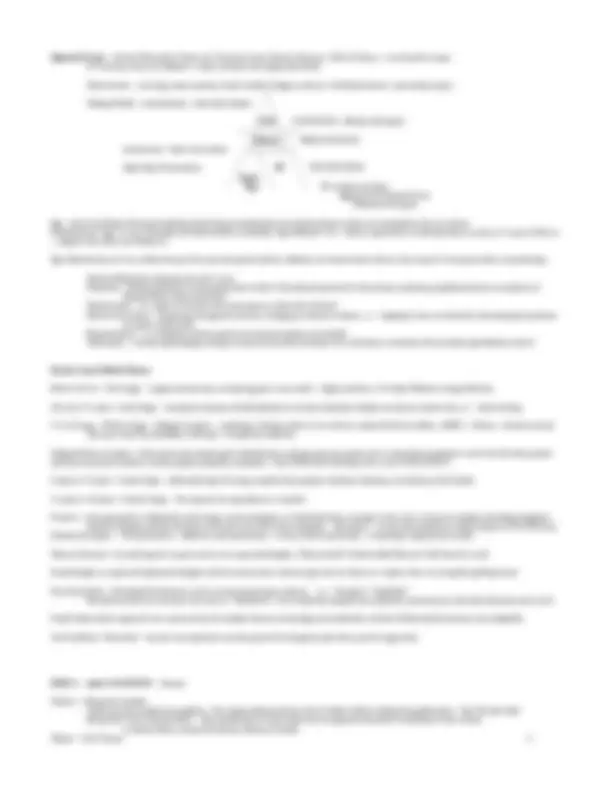
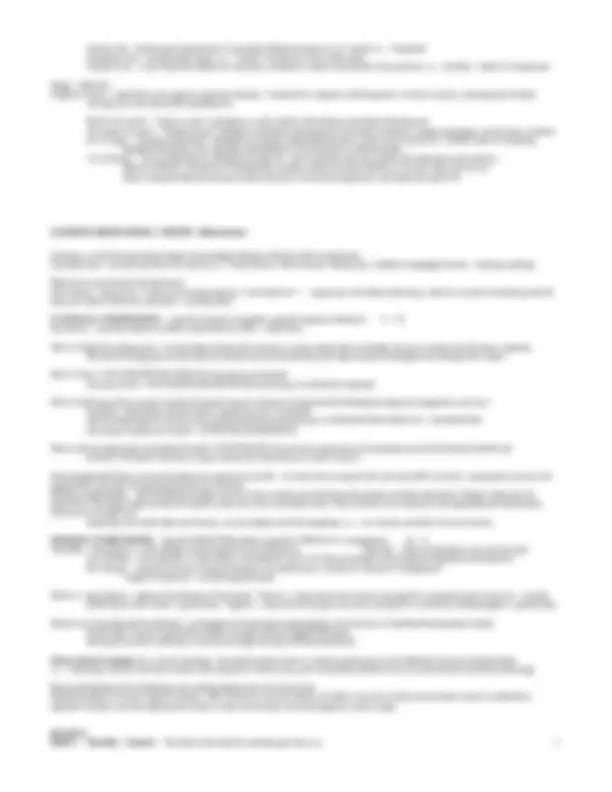
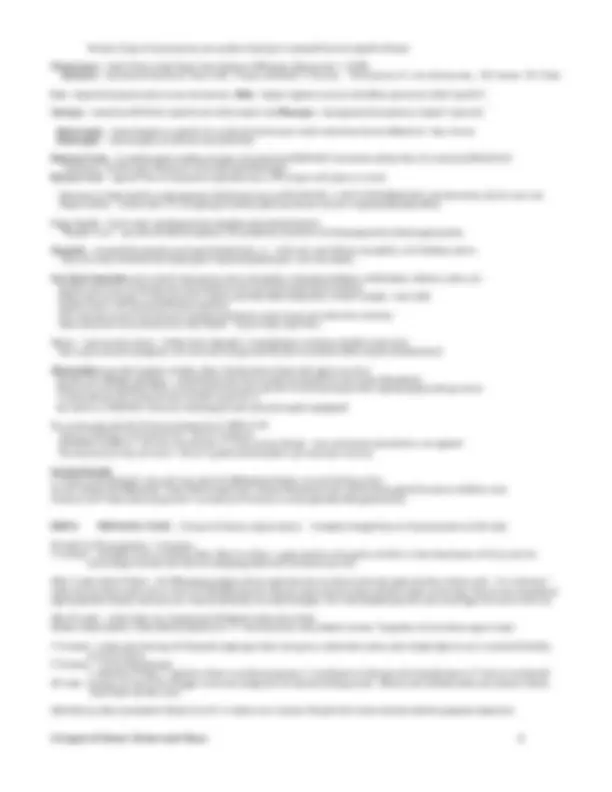
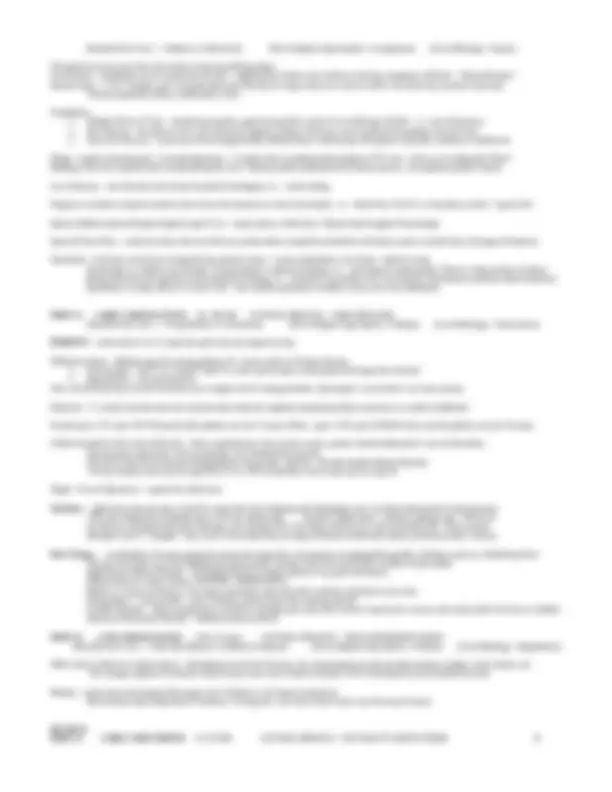
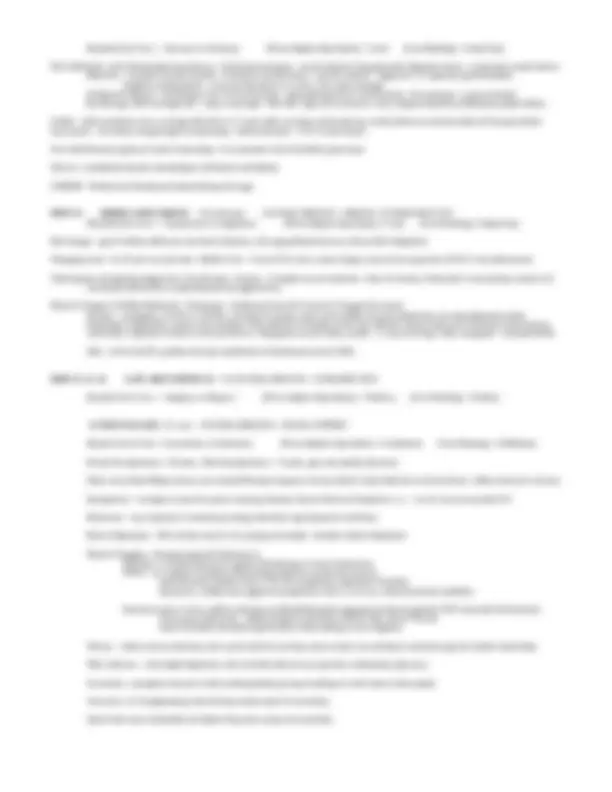



Study with the several resources on Docsity

Earn points by helping other students or get them with a premium plan


Prepare for your exams
Study with the several resources on Docsity

Earn points to download
Earn points by helping other students or get them with a premium plan
Community
Ask the community for help and clear up your study doubts
Discover the best universities in your country according to Docsity users
Free resources
Download our free guides on studying techniques, anxiety management strategies, and thesis advice from Docsity tutors
Full Couse Study Guide Material Type: Notes; Professor: Harris; Class: HUMAN DEVELOPMENT; Subject: Psychology; University: Towson University;
Typology: Study notes
1 / 10

This page cannot be seen from the preview
Don't miss anything!







PART 1 – HUMAN DEVELOPMENT Dr John Harris 1 A study of Growth & Change across the Life Span Humans have been “thinking about thinking” since the Dawn of Self-Awareness, (perhaps 1,000,000 years ago) Oldest written documents – 5,000 years ago, findings show that they were interested in cognition, language, reasoning, personality & mental illness Mental Illness = evil, damaged, “demons”: Present day - we are still cautious of people who are very different or who behave oddly History – people with mental illness suffered terribly: i.e. – Joan of Arc (possibly bipolar) was executed, i.e. – Salem Witch Trials; Women were probably condemned more than men Most cultures were influenced by church/religion, thus encouraged perception of “Right / wrong”, “Good / Evil” thus “Demonism” Exception – 1500 B.C. to 500 A.D. “The Golden Age of Greece & Rome” - They were practical, structured, militarily-influenced… Hippocrates – didn’t believe in demon/evil. He believed mental illness was a result of imbalances of "Humors" or body fluids. He labeled fluids descriptively, i.e. – “green phlegm”, “purple bile”, etc. Today we believe many or most mental illnesses are the result of or influenced by an imbalance of biochemistry (neurotransmitters) 500 A.D+ (BCE) – 1500 - The Dark Ages Many small cultures/civilizations; disintegrated, many of the Roman/Greeks’ advancements were lost 33% of the world’s population was wiped out, mostly due to opportunistic disease/poor hygiene, ie. Plaque, cholera, measles, whooping cough. Lepers – isolated & mistreated, hoarded into "leprosarium's" 1400 – 1700 organized witch hunts focused on persecution/execution of mentally ill Women. Renaissance – “The Awakening”, 1500’s; Improvements – better water distribution (thus improved hygiene), science & arts Leprosy declined .. so Mentally ill were gathered up and put in the leprosarium's .. creating the "Asyllums" John Locke – “Tabula Rosa”, (Latin for “blank slate”), Locke believed that we are all born with nothing, no thoughts But we know that in the 3rd trimester, sucking & swallowing develop. A genetically programmed behavior that disputes the idea of Tabula Rosa Rene Descartes – “philosophical scientist”. Nature vs. Nurture (“genetics” vs. “upbringing”) – an ongoing debate. Descartes thought you were born with a certain amount of potential, but environment affects how it developes. 19 th^ Century – Psychology was becoming more of a science, ideas and approaches (Paradigms) were developing. COGNITIVE – thinking/thoughts Willhelm Wundt – Leipzig University professor; had grad students list parts of the mind (memory, emotions, cognition, etc) through “Introspection”. This process could be replicated ANYWHERE. The process was called “structuralism”. William James – liked Wundt’s idea. He took the process a bit further by focusing on the “functions”, thus “Functionalism”. He divided memory into short term and long term. He was one of the 1st to label the unconsciousness. Sigmund Freud – pioneer, 1st person to put together comprehensive theories about Psycho-Dynamics, “how”, “why”, “what”. He believed a huge part of our mind was unconscious, ie. his dream theories. Two Drives – to aggress and to reproduce Ultimately Freud's students began to disagree with Freud's "Deterministic" philosophy .. ultimately leading to the "Humanist" movement. BEHAVIORISM – John Watson – “you can tell what’s going on by watching behavior” = behaviorism associate a behavior with a stimuli (i.e. – how we respond to a traffic light) Ivan Pavlov – Gave validity to Watson’s ideas in Moscow lab. i.e.: dogs/saliva. Gave us "Classical Conditioning" ie. Stimulus -> Response Edward Thorndike & B.F. Skinner augmented Pavlov's work with "Operent Conditioning" ie. Behavior -> Stimulus (consequence) EVOLUTIONARY – “how we got here from there” The scientific version of Genesis 120 years ago – due to misinformation anthropologists thought we were descendants from the apes & this offended many people. By exploring fossilized remains, we came to the conclusion we evolved in parallel with the apes. Natural Selection (“God’s plan”), i.e. – any mutation that improves (1) survivability, (2) reproductive capacity, (3) ability to rear offspring to reproductive age, Improves species chance of survival. BIOLOGICAL 1902 – “dementia-pox” (dementia = confusion) isolation of the Syphilis virus. Many people who were sexually active were coming down with dementia symptoms. Scientist were able to prove there was a biological explanation for mental illness (Dementia). HUMANIST 20 th^ century – Freud’s students (The Neo-Freudians) came to the realization that Freud’s theory was “deterministic” (like dominoes, one event affects another); “the opposite of freewill”. His students ultimately initiated the HUMANIST movement. Erik Erikson – thought humans are constantly adapting, changing and growing. This is the basis of his “Psycho-Social THEORY”. Erik Erikson – started out as an artist but he was not really artistically talented; became friends with Anna Freud (shared apartment complex). At the time he Was feeling despondent and she influenced/mentored him to be a psycho-analyst.
Pilgrimage to US in 1930's to escape Fascists brought many great minds to America : Einstein, Erikson, etc. 2 Erikson – no college degree, wrote books, influenced by Freud & Piaget Wrote "Childhood and Society", 1950 – won Pulitzer Prize, written in common language, introduced his Psycho-Social Theory: “There are 3 powerful forces that drive us through life” 1. Psycho. 2. Social. 3. Biological (from conception to death, “womb to tomb”) Erikson’s "Life Span" are divided into life stages which are defined/developed biologically; ie. The Epigenetic Principle – a biological plan for development, (Epi = time, Genetic = biological) In our D.N.A., there’s a plan for how we’re going to develop Life Stages are defined by a specific organization. Specific "Developmental Tasks unique to each stage (excluding the Prenatal stage). Central Process – a process that contributes to, or facilitates, mastery (achievement or success) in developing the tasks at any stage. i.e – infancy, the central process if “mutuality with caregiver” (birth mom). If the central process is in place, there’s a good chance the tasks will occur (i.e. – attachment, etc.). If the central process is not there, then we may struggle. Psycho-Social Crisis - A sense of self complacency (positive to negative continuum) that develops depending on the degree of success (or failure) in any stage. A "Prime Adaptive Ego Quality" (PAEQ) results from a positive resolution and a "Core Pathology" (Core Path) results from a negative resolution. PART 2 .. EVOLUTION EVOLUTIONARY Paradigm – “how we got here from there” The scientific version of Genesis We are in the Kingdom of “Animals” (as opposed to Plants); the Phylum of “Cordates”; the Sub-Phylum of “Vertebrates”; the Class of “Mammals”; the Order of “Primates”; the Family of “Hominids”; the Genus of “Homo” and the Species of “Sapiens Sapiens”. Let’s take a look at how that came to be. 120 years ago – due to misinformation anthropologists thought we were descendants from the apes & this offended many people. By exploring fossilized remains, we came to the conclusion we evolved in parallel with the apes. 12 million years ago a mutation genetically split us apart from the small ape-like pre-humans, the proconsuls. They had 24 chromosome pairs, but the joining of 2 chromosomes created a new species w 23 pairs that would eventually become the Australopithecus species, ultimately us. 8 million years ago major climatic changes began as the creation of the Himalayas altered the climate of Asia and Africa. This changed Africa from a dense jungle with ape like tree dwelling creatures to a divergent arid in parts and savanna and jungle in others, environment. This dynamic environment led to a remarkably divergent evolution of various species who competed for resources and/or survival. Recently a 3ft tall creature was unearthed; Ardipithicus Ramidus (“Ardi”) and found to be 4.4 million yrs old. This is currently the earliest BIPEDAL creature to be found. 3.2 million years ago (300K generations ago) “Lucy” (Australopithecus afarensis) lived. She was 4ft tall and territorial. They lived apprx 50 years. The Males competed for leadership roles and breeding rights. Many positive things came out of bipedal capability but the most significant may well have been the ability to rear young & enable them to survive to reproductive age due to being able to carry them. Being bipedal made “Lucy” a great Mom. Bipedalism also was energy efficient (compared to quadrupeds) enabling a slightly higher reproductive rate; 1/10th per generation is enough to make a big difference over time (natural selection). New species continued to evolve, Australopithecus africanus (2.6 m yrs) made primitive tools; Homo habillis (1.9 m yrs); Australopithecus bosei (1.7 m yrs); Homo ergaster (1.4 m yrs); Homo erectus (1 million yrs) captured fire; Homo Heidelbergensis evolved into Homo Neanderthalensis & Cro-Magnon (300, yrs) artwork, speech; Cro-Magnon became Homo sapiens sapiens (that’s us 100,000 yrs) fast food, space shuttle, etc. Self awareness may not have evolved until 1,000,000 yrs ago (or less). Evidence of "Spiritual" concern supports this theory. (funeral rites, burial grounds, paintings of "Symbolic" entities, etc.) 80,000 years ago – Final migration out of Africa for Homo sapiens began setting the stage for the development of our current 5 races (African, Caucasian, Malaysian, Asian & Native Americans (North & South); (Native Americans were the LAST to evolve and they had the greatest distance to migrate. The 1st^ in this period became the Aborigines in today’s Austrailia. Neanderthals (“cavemen” image) and Cro-Magnon migrated to Europe; Cro-Magnon they tailored their clothing, at the time the average temperature was 50 degrees colder than present day. Neanderthals may not have had sufficiently well developed larynxes though & couldn’t communicate enough to pass info on generationally. this issue may have led to their extinction. Cro-Magnon became our ancestors, they developed sophisticated tools. Some people think anthropology is against creationism /religion. BUT some, like Dr. Harris, think SCIENCE is "Intelligent Design". 98.5% of our genetic make-up is the same as gorillas, apes, etc. We are 99.9 % genetically identical to EACH OTHER. 40% identical to a banana. “The World of Koko” – suggestion to check it out; she has been taught 2000+ words with sign language Natural Selection (“God’s plan”), i.e. – any mutation that improves (1) survivability, (2) reproductive capacity, (3) ability to rear offspring to reproductive age, Improves species chance of survival. PART 3 .. SIGMUND FREUD's Psychodynamic (COGNITVE) Theory 3
Central Trait – the dominate characteristic, if you had to define someone in 1 or 2 words, i.e. – “outgoing” Secondary Trait – emerges under stress, i.e. – “macho” may become “shy” under stress Cardinal Trait – a role or position defines our character, we behave a certain way because of our position. i.e. – (cardinal – think of a clergyman) Piaget – 1930-40’s Cognitive Theory – studied how our cognitive capacities develop. Constructivist: sequence of development: we learn in layers, mastering basics before moving on to more advanced comprehension. Birth to 18 months – "Sensory motor" intelligence, myelin sheath is developing, neurological development 18 months to 6 years – “Preoperational” intelligence, foundation development, increasing vocabulary, categorizing things, sorting colors, numbers. 6 to 12 years – "Concrete operational" intelligence, starting to understand base (how we use zero), 6 years old = 14,000 words in vocabulary, READING being the most important (and predictive of success) skill a child developes. 12 to 18 years – "Formal operational" intelligence, by age 18 – you’ve reached maximum capacity for abstraction and creativity. Abstract thinking = the ability to conceptualize concepts without concrete evidence, ie. Gravity, light, atomics, etc. Many composers (Beethoven) and scientists (Einstein, Newton) did significant work before the age of 20. LEARNING (BEHAVIORAL) THEORY (Behaviorism) Learning = a relatively permanent change in knowledge, thinking or behavior due to experiences Learning Styles – everyone has their own system (i.e - Visual Learner , Motor learner– taking notes, Auditory (language) Learner – listening, reading). Behaviorism evolved into learning theory John Watson – behaviorist, 1st^ person for learning theories; “watch behavior” .. experiment with Albert (little boy), made him scared of everything white & fuzzy; he made a loud noise association = startling reflex CLASSICAL CONDITIONING – a specific stimulus can predict a specific response or behavior S -> B Ivan Pavlov – excellent attention to detail, astute observer; 1905 – Nobel Prize Pavlov’s Dog/Saliva Experiment – he chose dogs because they salivate vs. sweat; he put tubes in the dogs’ throats to measure the salivatory response. He noticed the dogs got excited when his assistant arrived (she fed them); the dogs learned to distinguish her footsteps from others’ Pavlov: Food = UNCONDITIONED STIMULUS (instinctive, unlearned) Salivate to food = UNCONDITIONED RESPONSE (salivating is an instinctive response) Pavlov tried using a bell (a neutral stimulus) & tested a host of variations of using the bell & feeding the dogs (he changed the wait time = Temporal relationship; the best results: ring bell & wait 2-5 seconds). Once the dogs begin to salivate to the sound of the bell the bell becomes a CONDITIONED STIMULUS = ACQUISITION Salivating in response to the bell = CONDITIONED RESPONSE Pavlov took the experiment even further & tried to “EXTINQUISH” the salivatory response by eliminating the association between the bell and the food. He found it took just as long to unlearn the relationship as it took to learn it. Once extinguished Pavlov removed the dogs from exposure to the bell. A month later he rang the bell and nearly 80% salivated = spontaneous recovery. He repeated this cycle until NO spontaneous recovery occurred. Biological preparedness: He tried putting the dogs away for 3 days without any food (traumatizing them) and then entered the "Hungry" dogs into the experiment. The hungry dogs learned more quickly, they were more motivated to learn. They were also more resistant to extinguishing, their spontaneous recovery was stronger also. Anything we do under high stress/trauma, we learn deeply and resist forgetting. i.e. – war veterans and other victims of trauma. OPERANT CONDITIONING a specific BEHAVIOR predicts a specific STIMULUS or consequence B -> S Thorndike – liked Pavlov’s work, thought of reversing the stimuli & behavior (“operant” – think of operating on our environment) Law of Effect – every behavior is followed by a consequence which will either encourage or discourage the repetition of the behavior B.F. Skinner – explored variations of specific behavior, he used the term “reinforcer” instead of “consequence” 2 types of reinforcers – rewards & punishments Positive + and Negative – applies to the direction of the stimuli. Positive + means the stimuli comes to you (put $ in machine & soda comes out = reward), (Officer gives you a ticket = punishment). Negative – means the stimuli goes away from you (put $ in machine & nothing happens = punishment). Skinner was a big advocate for education – he thought the chronological age groupings were incorrect, it should be developmental instead. Parents didn’t like the implied (but truthful) message that boys lagged behind girls. learning & rewards in education, rewards encourage learning more than punishment Observational Learning (a.k.a. Social Learning) – the reinforcement occurs to someone else but you are still affected (Vicarious reinforcement). i.e. – witnessing a failure at the soda machine with the person in front of you, you will probably decide not to try it yourself (you learned by observing) Rescorla & Bandura (UCLA-Berkeley; not working together but at the same time) Studied the effect of violent images & children. Their conclusion was that children who didn’t come from violent environments weren’t as affected as expected. Children who have experienced violence in their environment were encouraged by violent images. (EXAM 1) PART 5 Heredity – Genetics We inherit characteristics and then pass them on ; 5
We have 23 pairs of chromosomes, one member of each pair is inherited from our respective Parents. Chromosomes – think of them as big “buses”, they hold up to 5000 genes, (Human total = 25,000) Autosomes – chromosomes that do our “basic work”, 22 pairs, numbered 1-22 by size; Chromosomes 23 = sex chromosomes; XX= female XY= Male Loci – the particular gene location on any chromosome; Allele – the pair of genes at any loci that define a given trait. (think “parallel”) Genotype – instructions (DNA) for a specific trait which results in the Phenotype – the expressed characteristics, (“pheno”= physical) Heterozygous – when the genes at a specific loci on the chromosome pair contain instructions that are different (ie. blue, brown) Homozygous – when the genes are both the same (both blue) Dominant Traits – in a heterozygous condition one gene will contain the DOMINANT instructions and the other will contain the RECESSIVE instructions. The dominant instructions will be expressed (Phenotype) Recessive Trait – “ignored” but will be passed on reproductively in 50% of germ cells (sperm or ovum) Most traits are determined by a single gene pair (Allele) but some are POLYGENIC or MULTI-DETERMINANT, like Personality, IQ, skin color and Mental illnesses. In these cases 2 or more gene pairs (alleles) determine the how the trait is expressed (blended effect). Gregor Mendel – Czech monk, watched pea plants reproduce and collected statistics “Mendel’s Law” – use a box divided into quarters, 25% probability of recessive trait being expressed in heterozygous parents. Anomalies – unwanted but naturally occurring (inherited) traits, i.e. – sickle cell, cystic fibrosis, hemophilia, color blindness, autism. Many are recessive therefore the healthy gene is expressed (phenotype) = you’re be healthy. Sex Linked Anomalies occur on the X chromosome, such as hemophilia, male pattern baldness, colorblindness. Albinism, autism, etc Females receive two X chromosomes which function in the normal dominant/recessive fashion. Males receive an X and a Y chromosome (Y contains only testes determining factor, if there’s enough = male child) therefore there is NO Dominance/Recessive function. ANY anomaly on the X chromosome is therefore expressed in males 4 times more often than in females. Males inherit the X chromosomes from their Mother. If you’re bald, thank Mom. Autism - more common in boys – dislike touch, Asperger’s = hand gestures, sometimes retarded, savant (rare) Rare in girls (recessive polygenic), but more severe symptomatically due to cumulative effect, usually institutionalized Abnormalities occur due to genetic mistakes, often in the formation of germ cells (sperm or ovum) Females form Oocytes prenatally – which develop into Ovum as they are released from the ovaries after puberty. Many errors occur (possibly 50%) in the formation of oocytes when the 23 chromosome pairs don’t separate properly during meiosis. 1 oocyte ends up with 24 chomosomes, the other oocyte has 22 this results in a TRISOMY if the ovum containing the extra chromosome gets impregnated. As a women ages, the risk of trisomy increases from 1/1000 to 1/ Trisomy occurring in chromosome #21 = Down’s Syndrome Kelinfelters Syndrome – very rare, chromosomes x x y form trisomy. Results – boys with female characteristics, very agitated The only trisomy’s that can survive – Down’s Syndrome & Kleinfelter’s (all others don’t survive) Sex determination 1 st^ 20 days of life (prenatal) = stem cell mass, then Cell differentiation begins, we are all females at first. As cells multiply and differentiate “Testes Determining Factor” elevates testosterone levels and the female genital formation is shifted to male. A failure in the “Testes Determining Factor” can result an XY female or an hermaphrodite (both genitals) birth. PART 6 PRENATAL STAGE (Not part of Erikson's original theory) Conception through birth, no Central processes nor Dev tasks 40 weeks for Human gestation – 3 trimesters 1 st^ trimester – conception occurs in fallopian tubes. After 4 to 6 days = zygote attaches to the uterian wall (this is where the placenta will form), also the cervical plug is formed, stem cells are multiplying (these cells can become any cell). After 3 weeks (about 20 days) – cell differentiation begins and our zygote becomes an embryo (when the zygote attaches to uterine wall). It is in the next 7 weeks that the embryo enters into its most VULNERABLE period, when the central nervous system and basic organs are forming. They are very vulnerable to high temperature illnesses, chemicals, etc. These insults/threats are called teratogens. This is the foundation period, most miscarriages will occur at this time. After 10 weeks – called a fetus, has a beating heart & Babinski reflex (sole of feet) Gender is determined by "Testes determining factor on "Y" chromosome for males, default is female The gender will be visible at appx 6 weeks. 2 nd^ trimester – mother starts showing, 18-20 pounds weight gain, baby’s hair grows, mother feels motion, shine a bright light on mom’s stomach & the baby will turn to face it. 3 rd^ trimester – 3 critical developments:
(PsychoSocial Crisis = Trust vrs Mistrust) (Prime Adaptive Ego Quality = Hope) (Core Pathology = Withdrawal) Baby & mom develop a synchrony = a sense of rhythm or pattern of interaction (sleep, feed, eliminate). Mom feels a sense of attachment with baby. Baby’s temperament (and Mom's situation) can affect synchrony. If synchrony goes well, around 6 months of age (visual maturity), the baby will begin to perceive/see mom as separate = imprinting process begins. Separation Anxiety – around 6 months when vision improves and baby can see mom & see she’s separate. No memory has developed yet so baby can't maintain an internal image of Mom (Constancy) and doesn’t understand mom will come back. Mom can help by talking/singing from other room. Synchrony leads to Constancy – hopefully developed by around age 1. Constancy = the ability to remember internally an external image, i.e. – the ability to picture your mom when she’s not there (infants under 1 year can’t do this) Peek-a-boo game – may help baby develop "Constancy" and realize mom does come back. James Egan – researched the attachment/imprinting phenomenon and linked the remarkably increased rate of emotional problems in children with multiple caregivers in 1st^ year of life. He states that contact with baby every 2 hours can counteract this effect. He’s an advocate for putting daycares in offices (i.e. – Microsoft, IBM). 72% of households are dual-income now, meaning Mom's return to work MUCH more quickly than in the past. If constancy is not well developed baby will experience an insecure attachment = terrible 2’s, they have no ability to delay gratification because they Can't maintain an internal image of the object. Emotions at birth = pleasure & displeasure. By age 2 – mad, glad, sad, scared Baby will roll over, crawl, sit up, stand up, and take first step by age ONE. Also indulge in Holo-Phrases (non-sense sounds with Mom that may have meaning and become first words by age one. By the age of two(2) the baby should be "Toddling", speaking 100 words and using crude two word sentences (telegraphic speech). PART 8 TODDLERHOOD – 2 - 4 years: CENTRAL PROCESS – IMITATION (PsychoSocial Crisis = Autonomy vrs Shame & Doubt) (Prime Adaptive Ego Quality = Will) (Core Pathology = Compulsion) Semi-Otic Thinking (Language development) – babies & moms exchange sounds, infant matches sounds = “holophrases”; receptive speech, hearing sounds & attaching meaning. 2000 word vocabulary by the age of 4. Symbolism – fantasy play, pretending helps process anxiety, i.e. – imaginary friends, security blanket, playing with objects & assigning meaning, soothing mechanism, generally not problematic although some parents become concerned. Play – Solitary play prior to age 2 becomes Parallel play by the age of 3. Community play will develop by the age of 4, whereby children will Assign roles to one another to reenact real life issues to reduce anxiety. This becomes the mechanism that facilitates PLAY Therapy. Self-control, by 4 years of age the child should be able to start controlling impulses and anxiety. Rocking, tantrums and fantasy – helps control anxiety Toileting - Parents can expedite the process by taking advantage of the Central Process of "Imitation"; ie. Take the children to the bathroom with them and demonstrate the process. (PS - Dad's MUST sit down or little Girl's will be VERY confused). By age 4 child will be running, bounding and attempting to FLY. Discipline – Should be positively focused (REWARD) because it encourages POSITIVE SELF-ESTEEM; Punishment incourages NEGATIVE self esteem, especially if it is harsh, angry and/or physically/emotionally abusive in delivery. PART 9 EARLY SCHOOL YEARS – 4 to 6 years: CENTRAL PROCESS – IDENTIFICATION (PsychoSocial Crisis = Initiative vrs Guilt) (Prime Adaptive Ego Quality = Purpose) (Core Pathology = Inhibition) Usually the beginning of some kind of organized, structured program outside the home, ie. Kindergarten, "Head-start", etc. Same-gender identification (think of Freud’s Oediple/Electra complex, more boys struggle with identification than girls due to higher prevalence of missing Fathers). Shift is from OMNIPOTENT imitation of super heros (Mighty Morphine, Xena, etc) to "Real" people (same gender Parent). When identification process fails – child doesn’t develop capacity for remorse (Super-Ego). Sex-role identification – by age 6 children figure out the terms boy & girl = biological differences Children (especially boys) will now prefer same gender friends & claim to dislike opposites. Piaget – onset of heteronomous morality - Through identification, kids are taking on the same moral attributes as their same-sex parent. If there’s no parent (i.e. – Dad), then a role model. If morality is weak with Parent then child will internalize problem morals. SEX ABUSE - Pedophiles – 95% male, attracted to pre-pubic children, usually not gender specific, appears to be genetic and/or the pedophile was abused. Fred Berlin – Hopkins, 25 years of studying pedophiles. Sexual abuse = power, control. Self Theory - First 6 years of life – pretty narcissistic, hard to teach morals before age 6. Self esteem + - now established to some degree, generally measured in terms of perception of value to others. Developing empathy (understand feelings of others) and sympathy (understand & experience feelings of others). First experiences of guilt, what’s right or wrong. If identification doesn’t happen = asocial or antisocial, it’s a slow process but hard to reverse once it gets going, often turns criminal (no remorse). Higher prevalence in poverty. (EXAM 2) PART 10 MIDDLE CHILDHOOD 6 - 12 YRS CENTRAL PROCESS = EDUCATION 8
(PsychoSocial Crisis = Industry vrs Inferiority) (Prime Adaptive Ego Quality = Competence) (Core Pathology = Inertia) We spend more time away from home than at home (excluding sleep) Socialization – friendships are very important; Females – juggling best friends amid conflicts of the day, frequently; MALES – “Blood-Brothers” Research data – 1st^ & 2nd^ graders: girls were punished more severely for using violence to resolve conflict more than boys (cultural statement) Violence expected in Boys; condemned in Girls. Friendships:
PART 17 The End of LIFE Page 10 Elizabeth Kubler-Ross – famous books, “On Death & Dying” , her psychology can apply to any loss